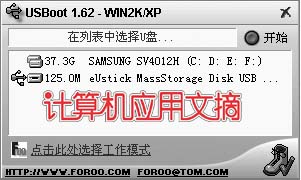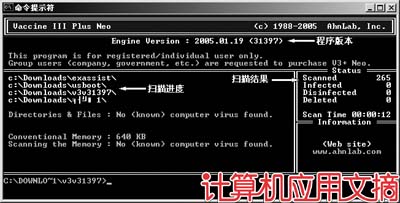禁止使用“重置WEB设置”
在HKEY_CURRENT_USER\Software\Policies\Microsoft\Internet Explorer\Control Panel下
在右边的窗口中新建一个DWORD值“Connection Settings”,并设值为“1”。
禁止更改IE的连接设置
在HKEY_CURRENT_USER\Software\Policies\Microsoft\Internet Explorer\Control Panel下
在右边的窗口中新建一个DWORD值“Connection Settings”,并设值为“1”。
禁止更改IE的语言设置
在HKEY_CURRENT_USER\Software\Policies\Microsoft\Internet Explorer\Control Panel下
在右边的窗口中新建一个DWORD值“Languages”,并设值为“1”。
禁止更改IE的辅助功能设置
在HKEY_CURRENT_USER\Software\Policies\Microsoft\Internet Explorer\Control Panel下
在右边的窗口中新建一个DWORD值“Accessibility”,并设值为“1”。
禁止IE显示“工具”中“INTERNET选项”
在HKEY_CURRENT_USER\Software\Microsoft\Windows\CurrentVersion\Policies\Explorer下
在右边的窗口中新建一个二进制值“NoFolderOptions”,并设值为“01 00 00 00”。
禁止使用鼠标右键
在HKEY_CURRENT_USER\Software\Microsoft\Windows\CurrentVersion\Policies\Explorer下
在右边的窗口中新建一个二进制值“NoViewContextMenu”,并设值为“01 00 00 00”。
修改后需重新启动WINDOWS,启动后,你将不能在桌面,驱动器,文件夹等地方使用鼠标右键
禁止磁盘空间不足时的警告
我们在安装软件的过程中,往往不能预料软件需要使用多大的磁盘空间,当空间不够的时候,
就会弹出一个空间不足的警告框,使用以下方法就是避免出现这个对话框
逐渐展开到HKEY_LOCAL_MACHINE\System\CurrentControlSet\Control\FileSystem下
在右边的窗口中新建一个二进制值“DisableLowDiskSpaceBroadcast”,并设值为“FF FF FF FF”,
如果想恢复出现这个警告框,只需删除此键。
禁止显示"远程管理"
在HKEY_USERS\.DEFAULT\Software\Microsoft\Windows\CurrentVersion\Policies\System下
在右边的窗口中新建一个DWORD值“NoAdminPage”,并设值为“1”。
禁止显示“注销”菜单
在HKEY_USERS\.DEFAULT\Software\Microsoft\Windows\CurrentVersion\Policies\Explorer下
在右边的窗口中新建一个二进制值“NoLogOff”,并设值为“01 00 00 00”。
禁止显示“开始”菜单中“收藏夹”菜单
在HKEY_USERS\.DEFAULT\Software\Microsoft\Windows\CurrentVersion\Policies\Explorer下
在右边的窗口中新建一个值“NoFavoritesMenu”,并设值为“1”。
禁止使用inf文件
在HKEY_LOCAL_MACHINE\Software\CLASSES\.inf下
在右边的窗口中更改“默认”值为“txtfile”
禁止使用reg文件
在HKEY_LOCAL_MACHINE\Software\CLASSES\.reg下
在右边的窗口中更改“默认”值为“txtfile”
禁用"打印机"中的"删除打印机"
在HKEY_USERS\.DEFAULT\Software\Microsoft\Windows\CurrentVersion\Policies\Explorer
下,在右边的窗口中新建DWORD值“NoDeletePrinter”,并设其值为“1”。
禁用"打印机"中的"添加打印机"
在HKEY_USERS\.DEFAULT\Software\Microsoft\Windows\CurrentVersion\Policies\Explorer
下,在右边的窗口中新建DWORD值“NoAddPrinter”,并设其值为“1”。
禁用“网络”控制面板
在HKEY_USERS\.DEFAULT\Software\Microsoft\Windows\CurrentVersion\Network\System
下,在右边的窗口中新建DWORD值“NoNetSetup”,并设其值为“1”。
禁用“用户”控制面板
在HKEY_USERS\.DEFAULT\Software\Microsoft\Windows\CurrentVersion\Policies\System
下,在右边的窗口中新建DWORD值“NoProfilePage”,并设其值为“1”。
禁用“密码”控制面板
在HKEY_USERS\.DEFAULT\Software\Microsoft\Windows\CurrentVersion\Policies\System
下,在右边的窗口中新建DWORD值“NoSecCPL”,并设其值为“1”。
禁止修改开始菜单
在HKEY_CURRENT_USER\Software\Microsoft\Windows\CurrentVersion\Policies\Explorer下
在右边的窗口中创建一个DOWRD值:"NoChangeStartMenu",并将其值设为“1”。
禁止修改“控制面版”
在HKEY_CURRENT_USER\Software\Microsoft\Windows\CurrentVersion\Policies\Explorer下
在右边的窗口中新建一个二进制"NoSetFolders",并将其值设为"01 00 00 00"。
禁止快速启动
在HKEY_LOCAL_MACHINE\System\CurrentControlSet\Control\Shutdown下
在右边的窗口中修改一个字符串值:“FastReboot”,并将其值设为“0”。
在退出WINDOWS时清除“文档”中的记录
在HKEY_CURRENT_USER\Software\Microsoft\Windows\CurrentVersion\Policies\Explorer下
在右边的窗口中新建一个二进制"ClearRecentDocsonExit",并将其值设为"01 00 00 00"。
不允许按ESC取消登录
在HKEY_LOCAL_MACHINE\Network\Logon下
在右边的窗口中创建一个DOWRD值:“MustBeValidated”,并将其值设为“1”,并且在在“网络”
属性里设置为“Windows友好登录”。
禁止使用注册表编辑文件regedit.exe
HKEY_USERS\.DEFAULT\Software\Microsoft\Windows\CurrentVersion\Policies\System
在右边的窗口中创建一个DOWRD值:"DisableRegistryTools",并将其值设为“1”。
恢复使用注册表编辑文件regedit.exe
当我们禁止使用注册表文件后,想恢复不是一件难事,下载这个文件,运行把注册表信息添加
到注册表,重新启动后即可使用注册表编辑器regedit.exe
禁止更改控制面板和打印机
HKEY_CURRENT_USER\Software\Microsoft\Windows\CurrentVersion\Policies\Explorer
在右边的窗口中创建一个DOWRD值:“NoSetFolders”,并将其值设为“1”。
禁止修改显示属性
HKEY_CURRENT_USER\Software\Microsoft\Windows\CurrentVersion\Policies\System
在右边的窗口中创建一个DOWRD值:“NoDispCPL”,并将其值设为“1”。
隐藏我的电脑中的驱动器
隐藏所有驱动器:HKEY_CURRENT_USER\Software\Microsoft\Windows\CurrentVersion\Policies\Explorer
在右边的窗口中创建一个DWORD值:“NoDrives”,并将其值设为“FFFFFFFF”;
隐藏E盘:HKEY_CURRENT_USER\Software\Microsoft\Windows\CurrentVersion\Policies\Explorer
在右边的窗口中创建一个DWORD值:“NoDrives”,并将其值设为“10”;
隐藏D盘:HKEY_CURRENT_USER\Software\Microsoft\Windows\CurrentVersion\Policies\Explorer
在右边的窗口中创建一个DWORD值:“NoDrives”,并将其值设为“8”;
隐藏C盘 :HKEY_CURRENT_USER\Software\Microsoft\Windows\CurrentVersion\Policies\Explorer
在右边的窗口中创建一个DWORD值:“NoDrives”,并将其值设为“4”。
隐藏A盘 :HKEY_CURRENT_USER\Software\Microsoft\Windows\CurrentVersion\Policies\Explorer
在右边的窗口中创建一个DWORD值:“NoDrives”,并将其值设为“1”。
退出不保存设置
HKEY_USERS\.DEFAULT\Software\Microsoft\Windows\CurrentVersion\Policies\Explorer
把二进制值“NoSaveSettings”改为“01 00 00 00”。
禁用MS—DOS方式
HKEY_CURRENT_USER\Software\Microsoft\Windows\CurrentVersion\Policies\Explorer
在该分支下新建主键“WinOlaApp",然后点击该主键,在右边的窗口中创建一个DWORD值“Disabled",
并设其值为“1”。
禁止“重新启动计算机切换到MS-DOS方式”
HKEY_CURRENT_USER\Software\Microsoft\Windows\CurrentVersion\Policies\Explorer
在右边的窗口中创建一个DWORD值“NoRealMode”,并设其值为“1”。
在“我的电脑”中显示“计划任务”
HKEY_LOCAL_MACHINE\Software\Microsoft\Windows\CurrentVersion\explorer\MyComputer\NameSpace
在该分支下创建一个主键“{D6277990-4C6A-11CF-8D87-00AA0060F5BF}”,在右边的窗口中创建字符串
“默认”,设值为“Scheduled Tasks”。
在“我的电脑”中显示“拨号网络”
HKEY_LOCAL_MACHINE\Software\Microsoft\Windows\CurrentVersion\explorer\MyComputer\NameSpace
在此分支下新建一个主键“{992CFFA0-F557-101A-88EC-00DD010CCC48}”,单击此主键,
在右边的窗口中创建一个字符串值:“默认”,并设值为"拨号网络"。
在我的电脑中显示“打印机”
HKEY_LOCAL_MACHINE\Software\Microsoft\Windows\CurrentVersion\explorer\MyComputer\NameSpace
在此分支下新建一个主键“{2227A280-3AEA-1069-A2DE-08002B30309D}”,单击此主键,
在右边的窗口中创建一个字符串值:“默认”,并设值为“打印机”。
禁止PC在出错时发出声音
HKEY_CURRENT_USER\Control Panel\Sound
在右边的窗口中,把字符串“Beep”的值改为“No”。
禁止CD-ROM自动运行
HKEY_LOCAL_MACHINE\SYSTEM\CurrentControlSet\Services\CDRom
在右边的窗口中,把DWORD值“Autorun”改为“0”。“1”表示自动运行。
禁止改变打印机设置
HKEY_CURRENT_USER\Software\Microsoft\Windows\CurrentVersion\Policies\Explorer
在右边窗口中创建DWORD值:“NoPrinters”,并设值为“1”。
禁止出现“点击这里开始”的提示
HKEY_CURRENT_USER\Software\Microsoft\Windows\CurrentVersion\Policies\Explorer
在右边的窗口中新建一个二进制值:“NoStartBanner”,设值为“01 00 00 00”。
在桌面上显示WINDOWS版本标志
HKEY_USERS\.DEFAULT\Control Panel\desktop
在右边的窗口中新建一个字符串值:“PaintDesktopVersion”,并设其值为“1”。
禁止在桌面上显示图标
我们安装了许多软件后,往往会在系统的桌面上出现许多图标,点击这些图标可以启动相应的软件程,
过多的图标使桌面变得花花绿绿,想恢复原来清洁的桌面,又不想删除这些图标,就可以使用一下的方
法,把桌面上的所有图标都隐藏起来。
在HKEY_USERS\.DEFAULT\Software\Microsoft\Windows\CurrentVersion\Policies\Explorer下
在右边的窗口中新建一个DWORD值:“NoDestop”,并设其值为“1”。
禁止显示提示
当我们把鼠标指向“我的电脑”,“我的文件夹”,“回收站”等图标时往往会出现一些提示信息,这些信息对一个熟悉WINDOWS的操作者来讲,是不必要的,我们想禁止显示这些提示,可使用下面的方法。
在HKEY_USERS\.DEFAULT\Software\Microsoft\Windows\CurrentVersion\Explorer\Advanced下
在右边的窗口中修改DWORD值“ShowInfoTip”,设其值为“0”。
禁止使用任务栏
在HKEY_CURRENT_USER\Software\Microsoft\Windows\CurrentVersion\Policies\Explorer下
在右边的窗口中新建一个DWORD值:“NoSetTaskBar”,并设其值为“1”。
此条技巧的作用是当我们在系统的任务栏上点击鼠标右键,再选择“属性”时,将会出现以下的提示信息:
“本次操作由于这台计算机的限制而被取消。请与你的系统管理员联系”。
高彩色显示图标
当我们按照完windows后,windows的图标都是用位数较小的色彩来显示图标的,使用下面的方法可以用
16位色显示图标,运行注册表编辑器,依次展开到HKEY_CURRENT_USER\ControlPanel\Desktop\WindowMetrics
在右边的窗口中找到字符串值:“Shell Icon BPP”,并设其值为“16”。
改变图标大小
HKEY_CURRENT_USER\Control Panel\Desktop\WindowMetrics
在右边的窗口中找到字符串值:“Shell Icon Size”,改变其值即改变图标大小,缺省值为“32”。
进入WINDOWS98时显示欢迎提示
HKEY_LOCAL_MACHINE\Software\Microsoft\Windows\CurrentVersion\Run
在右边的窗口中新建一个字符串值:“Welcome”,设值为“Welcome.exe /R”。
以12小时制显示时间
HKEY_USERS\.DEFAULT\Control Panel\International
在右边的窗口中找到字符串值:“sTimeFormat”,改其值为“h:mm tt”。
隐藏快捷方式的小箭头
HKEY_LOCAL_MACHINE\SOFTWARE\Microsoft\Windows\CurrentVersion\Explorer\Shell Icons
在右边的窗口中新建字符串值:“29”,设置其值为:“%WINDIR%\SYSTEM\docprop.dll,1”。
把快捷方式的小箭头更改为其它图标
HKEY_LOCAL_MACHINE\Software\Microsoft\Windows\CurrentVersion\explorer\Shell Icons
新建或修改字符串"29",设置其值为你的图标路径。
为快捷方式的图标加上小箭头
去掉了小箭头,怎么办,别急,按以下办法可以做上
HKEY_LOCAL_MACHINE\Software\Microsoft\Windows\CurrentVersion\explorer\Shell Icons
在右边窗口中删除字符串"29"。
禁止名称有“快捷方式”四个字
HKEY_CURRENT_USER\Software\Microsoft\Windows\CurrentVersion\Explorer
在右边的窗口中新建一个二进制值“link”,并设其值为“00 00 00 00”。
使用三键鼠标
在HKEY_LOCAL_MACHINE\SOFTWARE\Logitech\ouseWare\CurrentVersion \SerialV \0000下 ,
改为DoubleClick to 001。
更改WINDOWS系统的产品名
在HKEY_LOCAL_MACHINE\Software\Microsoft\Windows\CurrentVersion下
在右边的窗口中找到字符串值“ProductName”,更改键值即可。打开系统属性看看效果
更改WINDOWS系统的用户名
在HKEY_LOCAL_MACHINE\Software\Microsoft\Windows\CurrentVersion下
在右边的窗口中找到字符串值“RegisteredOwner”,更改键值即可。打开系统属性看看效果。
清除配色方案
在HKEY_CURRENT_USER\Control Panel\Appearance\Schemes下,
窗口的右边会出现系统自带的各种配色方案,将你认为无用的配色方案删除掉,一般只保留“Windows默认”一项。
禁止打开任何文件夹
在HKEY_CLASSES_ROOT\Folder\shell\open\ddeexec下,
在右边的窗口中修改字符串:“(默认)”的值设为“rem [ViewFolder("%l", %I, %S)]”;
同时在HKEY_CLASSES_ROOT\Folder\shell\explore\ddeexec下
在右边的窗口中修改字符串:“(默认)”的值设为“rem [ViewFolder("%l", %I, %S)]”。
自动关闭电源
在HKEY_LOCAL_MACHINE\SOFTWARE\Microsoft\WindowsNT\CurrentVersion\Winlogon下,
在右边的窗口中创建一个DWORD值:“PowerdownAfter Shutdown”,并将其值设为“1”。
允许强制关闭系统
在我们运行程序的时候,有时会遇到软件程序没反映的现象,于是我们按CTRL+ALT+DEL来关闭系统,
而当我们按下后,系统会叫我们退出前要使软件程序退出,使用本功能可允许强制关闭系统。
在HKEY_USERS\.DEFAULT\ControlPanel\desktop下,在右边的窗口中创建一个字符串值:“AutoEndTask s”,并将其值设为“1”。
禁止光标闪动
在HKEY_USERS\.DEFAULT\Control Panel\desktop下
在右边的窗口中创建一个字符串值:“CursorBlinkRate”,并将其值设为“-1”。
删除“查找”命令保留在注册表中的搜索结果
在HKEY_USERS\.DEFAULT\Software\Microsoft\Windows\CurrentVersion\Explorer\Doc Find Spec MRU 下删除右边窗口中的键。
进入Win98前给出警告信息
在HKEY_LOCAL_MACHINE\Software\Microsoft\Windows\CurrentVersion\Winlogon下
键值:″LegalNoticeCaption″=″问候″
说明:这是信息框的标题。
键值:″LegalNoticeText″=″欢迎光临″ 说明:这是信息框的文本内容。
WINDOWS98登录口令
HKEY_LOCAL_MACHINE\Network\Logon
在右边的窗口中创建一个DOWRD值:"MustBeValidated",并将其值设为“1”,在启动WINDOWS98后
按ESC键将不能显示画面。
开机时进行“多用户登录”选择
在HKEY_LOCAL_MACHINE\Network\Logon下
在右边的窗口中创建一个DOWRD值:“UserProfiles”,并将其值设为“1”。
开机时自动登录系统
在HKEY_LOCAL_MACHINE\Software\Microsoft\Windows\CurrentVersion\Winlogon下
在右边的窗口中创建字符串值:“AutoAdminLogon”,并将其值设为“1”;还创建字符串值“DefaultP assword”,其值为登录时的密码,创建字符串值:“DefaultUserName”,其值为登录时
所用的用户名。对单机用户有意义。
自动更新
HKEY_LOCAL_MACHINE\System\CurrentControlSet\Control\Update
把二进制值“UpdateMode”改为“00 00 00 00”。
鼠标自动激活当前窗口
HKEY_USERS\.DEFAULT\Control Panel\desktop
把二进制值“UserPreferencemask”改为“AF 00 00 00”。
查看安装时输入的WIN98密码
HKEY_LOCAL_MACHINE\Software\Microsoft\Windows\CurrentVersion
点击“ProductKey”,即可看到。
改变WINDOWS有关文件的安装路径
HKEY_LOCAL_MACHINE\Software\Microsoft\Windows\CurrentVersion\Setup
在右边的窗口中,有“BootHost”、“BootDir”、“SourcePath”、“MediaPath”.....
改变其数据内容,就可改变相关文件的路径。
设立缺省的用户名和公司名称
HKEY_CURRENT_USER\Software\Microsoft\MS Setup (ACME)\User Info
在右边窗口中找到字符串值:“DefCompany”,“DefName”,DefCompany是指公司名称,
DefName是指用户名。
注册你的WINDOWS98。
HKEY-LOCAL-MACHINE\SOFTWARE\Miscrosoft\Windows\CurrentVersion\
在右边的窗口中将“Regdone”的值改为“1”。
自动运行光碟
HKEY_USERS\.DEFAULT\Software\Microsoft\Windows\CurrentVersion\Policies\Explorer
在右边的窗口中创建一个二进制值:“NoDriveTypeAutoRun”,并将其值设为“95 00 00 00”
想禁止自动运行,只需改为"b5 00 00 00"。
自动播放光碟
在HKEY_CLASSES_ROOT\AudioCD\shell下
在右边的窗口中修改字符串值:“默认”,改其值为空格。
直接显示图片内容
HKEY_CLASSES_ROOT\Paint. Picture\DefaultIcon
在右边的窗口中,找到字符串“默认”,修改值为“%1”。
添加或删除启动时自动运行的程序
在HKEY_LOCAL_MACHINE\Software\Microsoft\Windows\CurrentVersion\下,把鼠标点击“RUN”,
在右边的窗口中,按相应的方法添加或删除启动时自动运行的程序。
过滤IP(适用于WIN2000)
在HKEY_LOCAL_MACHINE\System\CurrentControlSet\Services\Tcpip\Parameters下
在右边的窗口中修改双字节“EnableSecurityFilters”的值为“1”。
禁止显示IE的地址栏
在HKEY_CLASSES_ROOT\CLSID\{01E04581-4EEE-11d0-BFE9-00AA005B4383}\InProcServer32下
在右边的窗口中修改字符串“默认”的值为“rem C:\WINDOWS\SYSTEM\BROWSEUI.DLL”。
禁止使用IE“internet选项”中的高级项(winnt适用)
在HKEY_CURRENT_USER\Software\Policies\Microsoft\Internet Explorer\Control Panel下
在右边的窗口中新建一个DWORD值“AdvancedTab”,并设值为“1”。
禁止更改IE默认的检查(winnt适用)
在HKEY_CURRENT_USER\Software\Policies\Microsoft\Internet Explorer\Control Panel下
在右边的窗口中新建一个DWORD值“ProgramsTab”,并设值为“1”。
允许DHCP(winnt适用)
在HKEY_LOCAL_MACHINE\SYSTEM\CurrentControlSet\Services\{Adapter}\Parameters\Tcpip下
在右边的窗口中新建一个DWORD值“EnableDHCP”,并设值为“1”。
局域网自动断开的时间(winnt适用)
在HKEY_LOCAL_MACHINE\SYSTEM\CurrentControlSet\Services\LanmanServer\Parameters下
在右边的窗口中新建一个DWORD值“Autodisconnect”,并设值为你想要设置的分钟数。
禁止使用“重置WEB设置”
在HKEY_CURRENT_USER\Software\Policies\Microsoft\Internet Explorer\Control Panel下
在右边的窗口中新建一个DWORD值“Connection Settings”,并设值为“1”。
禁止更改IE的连接设置
在HKEY_CURRENT_USER\Software\Policies\Microsoft\Internet Explorer\Control Panel下
在右边的窗口中新建一个DWORD值“Connection Settings”,并设值为“1”。
使打开IE时候,窗口最大化
在HKEY_CURRENT_USER\Software\Microsoft\Internet Explorer\Main\ 下
在右边的窗口中删除Window_Placement,并且
在HKEY_CURRENT_USER\Software\Microsoft\Internet Explorer\Desktop\Old WorkAreas 下
在右边的窗口中删除OldWorkAreaRects 。
禁止更改IE的语言设置
在HKEY_CURRENT_USER\Software\Policies\Microsoft\Internet Explorer\Control Panel下
在右边的窗口中新建一个DWORD值“Languages”,并设值为“1”。
禁止更改IE的辅助功能设置
在HKEY_CURRENT_USER\Software\Policies\Microsoft\Internet Explorer\Control Panel下
在右边的窗口中新建一个DWORD值“Accessibility”,并设值为“1”。
禁止IE显示“工具”中“INTERNET选项”
在HKEY_CURRENT_USER\Software\Microsoft\Windows\CurrentVersion\Policies\Explorer下
在右边的窗口中新建一个二进制值“NoFolderOptions”,并设值为“01 00 00 00”。
清理IE网址列表
HKEY_CURRENT_USER\Software\Microsoft\Internet Explorer\TypedURLs
在右边的窗口中删除想要删除的网址。
禁止使用代理服务器
代理服务器的用途很大,比如可以使原来只能国内站点的电脑,在使用代理服务器后,能访问国外站点
但代理服务器的使用也会带来不利的地方,因此,我们可以通过注册表来禁止使用代理服务器,
在HKEY_LOCAL_MACHINE\Config\0001\Software\Microsoft\windows\CurrentVersion\Internet Settings下
在右边的窗口中新建二进制值“ProxyEnable”的键值为"00 00 00 00"。
在IE中禁止显示工具栏
在 HKEY_USERS\.DEFAULT\Software\Microsoft\Internet Explorer\Main 下
在右边的窗口中修改字符串“Show_URLToolBar”的键值为"no"。
在IE中禁止显示状态栏
在 HKEY_USERS\.DEFAULT\Software\Microsoft\Internet Explorer\Main 下
在右边的窗口中修改字符串“Show_StatusBar”的键值为"no"。
更改"应用程序"的文件夹的路径在HKEY_USERS\.DEFAULT\Software\Microsoft\Windows\CurrentVersion\Explorer\User Shell Folders
下,在右边的窗口中修改字符串“Recent”的键值为新的文件夹路径,如:C:\cpu ,注意:cpu这个文件 夹必须是存在的,否则新建一个文件夹。
更改"应用程序数据"的文件夹路径在HKEY_USERS\.DEFAULT\Software\Microsoft\Windows\CurrentVersion\Explorer\User Shell Folders
下,在右边的窗口中修改字符串“AppData”的键值为新的文件夹路径。
为同一部电脑设置2个IP地址
在HKEY_LOCAL_MACHINE\System\CurrentControlSet\Services\Class\NetTrans下
点击0000、0001,0002.....留意右边的窗口,当你发现右边窗口中的字符串"DriverDesc"的值
为"TCP/IP",修改同一窗口中的字符串"IPAddress"和"IPMask",把IPAddress设为IP地址
如"198.0.1.9,198.0.1.7",把"IPMask"设为对应的掩码,如"255.255.255.0,255.255.255.0"
更改Internet Explorer的标题
在HKEY_CURRENT_USER\Software\Microsoft\Internet Explorer\Main下
在右边的窗口中新建字符串值“Window Title”为新标题的名字。
更改outlook express的标题
在HKEY_CURRENT_USER\Identities\{44453E40-8AFB-11D4-9E02-B0A2A20F384F}\ Software\Microsoft\Ou tlook Express\5.0下,在右边的窗口中新建字符串值“WindowTitle”为新的标题 名字。{}里的内容不一定相同。
改变“超级链接”处点击前后的颜色
在HKEY_CURRENT_USER\Software\Microsoft\Internet Explorer\Settings下
在右边的窗口中修改“Anchor Color”和“Anchor Color Visited”的值即可修改
修改点击前后的颜色。
清理访问“网络邻居”后留下的字句信息
在HEKY_CURRENT_USER/Network/Recent下
删除下面的主键。
加快上网速度
以下有几项方法可以改变上网速度:
HKEY_LOCAL_MACHINE\System\CurrentControlSet\Services\VxD\MSTCP
在右边的窗口中把“DefaultRcvWindow”的值改为“6400”,把“DefaultTTL”改为“128”。
HKEY_LOCAL_MACHINE\System\CurrentControlSet\Services\Class\NetTrans
在右边窗口中创建字符串值“MaxMTU”,“MaxMSS”,并设“MaxMTU”为“576”,设“MaxMSS”
为“536”。
禁止使用网上邻居
在 KEY_USERS\.DEFAULT\Software\Microsoft\Windows\CurrentVersion\Policies\Explorer下
在右边窗口中创建DWORD值“NoNetHood”,并设为“1”。
改变和增加IE自动搜索的顺序
在HKEY_LOCAL_MACHINE\Software\Microsoft\Internet Explorer\Main\UrlTemplate下
在右边窗口中,我们可以看到有几个字符串,IE按照1,2,3,4....的顺序进行自动搜索,调整1,2,
3,4...字符串的键值互相交换,即可调整自动搜索的顺序,亦可新建字符串,增加自动搜索的内容。
在“开始”菜单中增加“网上邻居” 在HKEY_LOCAL_MACHINE\Software\Microsoft\Windows\CurrentVersion\explorer\NetworkNeighborhood
下新建主键“NameSpace”,然后在 HKEY_USERS\.DEFAULT\Software\Microsoft\Windows\CurrentVersion\Explorer\MenuOrder\StartMenu\
下新建主键“网上邻居”。
禁止在"控制面板"中显示"网络"属性
在HKEY_USERS\.DEFAULT\Software\Microsoft\Windows\CurrentVersion\Policies\Explorer下
在右边的窗口中新建DWORD值“NoNetSetup",并设其值为“1”。
禁止在“网络”中显示“标识”属性
在HKEY_USERS\.DEFAULT\Software\Microsoft\Windows\CurrentVersion\Policies\Network下
在右边的窗口中新建DWORD值“NoNetSetupIDPage”,并设其值为“1”。
禁止在“网络”中显示“整个网络”属性
在HKEY_USERS\.DEFAULT\Software\Microsoft\Windows\CurrentVersion\Policies\Network下
在右边的窗口中新建DWORD值“NoEntireNetwork”,并设其值为“1”。
更改IE的缓冲的路径
在HKEY_USERS\.DEFAULT\Software\Microsoft\Windows\CurrentVersion\Explorer\User Shell Folders 下更改“Cache”的路径即可。
改变下载的路径
在HKEY_USERS\.DEFAULT\Software\Microsoft\Internet Explorer下
在右边的窗口中新建DWORD值“Download Directory”,并设其值为你想要的下载路径,如C:\My Documents。
禁止查找用户
在HKEY_LOCAL_MACHINE\Software\Microsoft\Windows\CurrentVersion\ explorer\FindExtensions\Stat ic\WabFind下,删除主键“WabFind”。
改变收藏夹、Cookies、启动、历史记录的路径
在HKEY_USERS\.DEFAULT\Software\Microsoft\Windows\CurrentVersion\ Explorer\User Shell Folders 下找到字符串值“Favorites”,并设其值为你想要的下载路径,如C:\WINDOWS \Favorite。
在此窗口中可更改桌面的路径、Cookies的路径、启动的路径、历史记录的路径。
创建"拨号网络"在开始菜单中
打开任务栏和开始菜单,选择“高级”,在右边的窗口中新建文件夹
“拨号网络.{992CFFA0-F557-101A-88EC-00DD010CCC48}”。
网址URL的调整
我们在使用IE上网时输入的网址,会在注册表里面留下一些记录,记录着你输入过那些网址,当你下次再输入该网址时,只需输入几个字母,IE就会自动的 输入完整的网址,大大方便了我们,在以下的方法中,我们可以手动的在WINDOWS的注册表中增加一些网址URL,使上网时更方便。
依次展开在HKEY_CURRENT_USER\Software\Microsoft\Internet Explorer\TypedURLs下
在右边的窗口中按url1、url2、url3......顺序排列着一些URL,修改,增加,删除这些url的值
即可达到修改,增加,删除URL的功能。
取消登录时选择用户
已经删除了所有用户,但登录时还要选择用户,我们要取消登录时选择用户,就要
在HKEY_LOCAL_MACHINE\Network\Logon下,在右边的窗口中,修改"UserProfiles"值为"0"。
重新启动WINDOWS,使这条技巧生效。
隐藏上机用户登录的名字
在HKEY_LOCAL_MACHINE\Software\Microsoft\Windows\CurrentVersion\Winlogon下
在右边的窗口中新建字符串"DontDisplayLastUserName",设值为"1"。
显示“频道栏”
在HKEY_CURRENT_USER\Software\Microsoft\Internet Explorer\Main下
在右边的窗口中修改字符串"Show_ChannelBand"为"yes"。
增加键盘的缓冲(适用于WIN2000)
依次打开至HKEY_LOCAL_MACHINE\System\CurrentControlSet\Services\Kbdclass\Parameters下,
在右边窗口中修改“KeyboardDataQueueSize”的值为你想要的缓存大小。
增加鼠标缓冲区(适用于WIN2000)
依次打开至HKEY_LOCAL_MACHINE\System\CurrentControlSet\Services\Kbdclass\Parameters下,
在右边窗口中创建“MouseDataQueueSize”的双字节值,并设其值为你想要的缓存区大小。
在WINDOWS2000启用UDMA66的功能(适用于WIN2000)
依次打开至HKEY_LOCAL_MACHINE\System\CurrentControlSet\Control\Class\ {4D36E96A-E325-11CE-BFC 1-08002BE10318}\0000下,在右边窗口中创建“EnableUDMA66”的双字节 值,并设其值为“1”。
启用CPU的二级缓存(适用于WIN2000)
在HKEY_LOCAL_MACHINE\System\CurrentControlSet\Control\SessionManager\Memory Management下
在右边窗口中,我们可以更改“SecondLevelDataCache”的数值为CPU设置相应的数据。
调整“帝国时代”游戏的速度
在HKEY_USERS\.Default\Software\Microsoft\Games\Age of Empires\1.00下
在右边窗口中,我们可以看到“Game speed”的数值就是速度大小。
硬盘读取“星际”游戏
现在星际非常流行,但大家是否觉得星际用光盘太麻烦,我现在就介绍一种通过修改注册表来实现硬盘
读取游戏的方法:
1:安装星际
2:打开注册表编辑器
3:找到子键HKEY_LOCAL_MACHINE\Software\Blizzard Entertainment\starcraft在右边窗口中找到InstallPath,
如果键值是E:\……,就把E该为本地硬盘驱动器就行了。
找回FLASH的序列号SN
在HKEY_LOCAL_MACHINE\Software\Macromedia\Flash\4\Registration\Serial Number 下
在右边窗口中,我们可以看到“默认”的数值就是FLASH的序列号
找回DREAMWEAVER3的序列号SN
想重装DREAMWEAVER,但不记得序列号了,怎么办?别急,按下面做就可找会DREAMWEAVER3的SN
在 HKEY_LOCAL_MACHINE\Software\Macromedia\Dreamweaver\3\Registration 下
在右边窗口中,我们可以发现键名为"Serial Number"的字符串,其数据就是DREAMWEAVER的序列号
“红心接龙”游戏作弊
在HKEY_USERS\.DEFAULT\Software\Microsoft\Windows\CurrentVersion\Applets\Hearts下
在右边窗口中新建字符串"zb",设其值为"42"。
隐藏输入的密码
在HKEY_LOCAL_MACHINE\Software\Microsoft\Windows\CurrentVersion\Policies\Network下
在右边窗口中新建DWORD值"HideSharePwds",设其值为"1"。
优化硬盘驱动器
在HKEY_LOCAL_MACHINE\System\CurrentControlSet\Control\FileSystem下
在右边的窗口中创建二进制值"NameCache",NameCache是文件名缓存,32MB系统建议值为800000,
64MB系统建议值为0F00000;PathCache是路径缓存,32MB系统建议为008000,64MB系统建议为0F0000。
超频Trident Imagine 9750系列显卡
在HKEY_LOCAL_MACHINE\SOFTWARE\Trident Microsystems下
找到文件夹“D3DPerformance”,修改“D3DPerf”为5或7,修改“CkBlinerOn”为2,
改变最大图标缓冲
HKEY_LOCAL_MACHINE\Software\Microsoft\Windows\CurrentVersion\explorer
在右边的窗口中找到字符串值:“Max Cached Icons”,设其值为“7500”。
清除“开始”中的“运行”的历史记录
HKEY_CURRENT_USER\Software\Microsoft\Windows\CurrentVersion\Explorer\RunMRU
删除右边窗口中的“a,b,c,d.....”,即可删除历史记录。
优化软盘驱动器的性能
HKEY_LOCAL_MACHINE\System\CurrentControlSet\Services\Class\fdc\0000
在右边的窗口中创建一个字符串值:“ForceFIFO”,设值为“0”。
优化文件系统
HKEY_LOCAL_MACHINE\System\CurrentControlSet\Control\FileSystem
在右边的窗口中创建一个DWORD值:“ConfigFileAllocSize”,并设为“1f4”。
加快上网速度
以下有几项方法可以改变上网速度:
HKEY_LOCAL_MACHINE\System\CurrentControlSet\Services\VxD\MSTCP
在右边的窗口中把“DefaultRcvWindow”的值改为“6400”,把“DefaultTTL”改为“128”。
HKEY_LOCAL_MACHINE\System\CurrentControlSet\Services\Class\NetTrans
在右边窗口中创建字符串值“MaxMTU”,“MaxMSS”,并设“MaxMTU”为“576”,设“MaxMSS”
为“536”。
巧解IE的分级审查口令
首先备份注册表文件,然后通过运行regedit来打开注册表。
定位到HKEY_LOCAL_MACHINE\SOFTWARE\Microsoft\Windows\CurrentVersion\Policies\Ratings,
用鼠标选中右半窗口里的名称记录,按下Del键进行删除。退出注册表,然后重新启动,就可以解开分级审查的口令了。
更改网络工作组图标
在HKEY_LOCAL_MACHINE\Software\Microsoft\Windows\CurrentVersion\explorer\Shell Icons下
在右边的窗口中新建字符串值"2",并设其值为新图标的路径。
更改WEB文件夹图标
HKEY_LOCAL_MACHINE\Software\CLASSES\CLSID\{BDEADF00-C265-11D0-BCED-00A0C90AB50F}\DefaultIc,
在右边的窗口中修改"默认"为新图标的路径。
更改DOS程序的图标
在HKEY_LOCAL_MACHINE\Software\Microsoft\Windows\CurrentVersion\explorer\Shell Icons
下,在右边的窗口中新建字符串值"2",并设其值为新图标的路径。
更改5寸软盘的图标
在HKEY_LOCAL_MACHINE\Software\Microsoft\Windows\CurrentVersion\explorer\Shell Icons
下,在右边的窗口中新建字符串值"5",并设其值为新图标的路径。
更改可移动驱动器的图标
在HKEY_LOCAL_MACHINE\Software\Microsoft\Windows\CurrentVersion\explorer\Shell Icons
下,在右边的窗口中新建字符串值"5",并设其值为新图标的路径。
更改"注销"的图标
在HKEY_LOCAL_MACHINE\Software\Microsoft\Windows\CurrentVersion\explorer\Shell Icons
下,在右边的窗口中新建字符串值"44",并设其值为新图标的路径。
更改"运行"的图标
在HKEY_LOCAL_MACHINE\Software\Microsoft\Windows\CurrentVersion\explorer\Shell Icons
下,在右边的窗口中新建字符串值"24",并设其值为新图标的路径。
更改"关闭系统"的图标
在HKEY_LOCAL_MACHINE\Software\Microsoft\Windows\CurrentVersion\explorer\Shell Icons
下,在右边的窗口中新建字符串值"27",并设其值为新图标的路径。
更改"收藏夹"的图标
在HKEY_LOCAL_MACHINE\Software\Microsoft\Windows\CurrentVersion\explorer\Shell Icons
下,在右边的窗口中新建字符串值"43",并设其值为新图标的路径。
更改"查找"的图标
在HKEY_LOCAL_MACHINE\Software\Microsoft\Windows\CurrentVersion\explorer\Shell Icons
下,在右边的窗口中新建字符串值"22",并设其值为新图标的路径。
更改"开始"菜单中"程序"的图标
在HKEY_LOCAL_MACHINE\Software\Microsoft\Windows\CurrentVersion\explorer\Shell Icons
下,在右边的窗口中新建字符串值"19",并设其值为新图标的路径。
更改pbl文件的图标
在HKEY_CLASSES_ROOT下查找键值"pblfile",
并在这个主键的\DefaultIcon,修改右边窗口中的“默认”值为新图标的路径.
更改Internet Explorer的图标
HKEY_LOCAL_MACHINE\Software\CLASSES\CLSID\{871C5380-42A0-1069-A2EA-08002B30309D}\DefaultIcon,
在右边的窗口中修改字符串值“(默认)”为新图标的路径,如:“C:\w.ico,0”。
更改"打开的文件夹"的图标
在HKEY_LOCAL_MACHINE\Software\Microsoft\Windows\CurrentVersion\explorer\Shell Icons
下,在右边的窗口中新建字符串值"4",并设其值为新图标的路径。
更改3寸软盘的图标
在HKEY_LOCAL_MACHINE\Software\Microsoft\Windows\CurrentVersion\explorer\Shell Icons
下,在右边的窗口中新建字符串值"6",并设其值为新图标的路径。
更改IE的图标
在HKEY_LOCAL_MACHINE\Software\CLASSES\CLSID\{871C5380-42A0-1069-A2EA-08002B30309D}\DefaultIcon
下,在右边的窗口中修改字符串值“(默认)”为新图标的路径。
更改"我的公文包"的图标
在HKEY_LOCAL_MACHINE\Software\CLASSES\CLSID\{85BBD920-42A0-1069-A2E4-08002B30309D}\DefaultIcon
下,在右边的窗口中修改字符串值“(默认)”为新图标的路径。
更改“计划任务”的图标
在HKEY_LOCAL_MACHINE\Software\CLASSES\CLSID\{D6277990-4C6A-11CF-8D87-00AA0060F5BF}\DefaultIcon
下,在右边的窗口中修改字符串值“(默认)”为新图标的路径。
更改“收件箱”的图标
在HKEY_LOCAL_MACHINE\Software\CLASSES\CLSID\{00020D75-0000-0000-C000-000000000046}\DefaultIcon
下,在右边的窗口中修改字符串值“(默认)”为新图标的路径。
给“控制面板”改名、改图标
在HKEY_LOCAL_MACHINE\Software\CLASSES\CLSID\{21EC2020-3AEA-1069-A2DD-08002B30309D}下
在右边的窗口中修改字符串值“(默认)”为新的名称
改图标:在HKEY_LOCAL_MACHINE\Software\CLASSES\CLSID\{21EC2020-3AEA-1069- A2DD-08002B30309D}\DefaultIcon下,在右边的窗口中修改字符串值“(默认)”为新图标的路径。
更改“打印机”图标
在HKEY_LOCAL_MACHINE\Software\CLASSES\CLSID\{2227A280-3AEA-1069-A2DE-08002B30309D}\DefaultIcon
下,在右边的窗口中修改字符串值“(默认)”为新图标的路径。
给“回收站”改名、改图标
HKEY_CLASSES_ROOT\CLSID\{645FF040-5081-101B-9F08-00AA002F954E}
在右边的窗口中找到字符串值:“默认”,把“回收站”改为其它名称。
HKEY_CLASSES_ROOT\CLSID\{645FF040-5081-101B-9F08-00AA002F954E}\DefaultIcon
在右边的窗口中修改图标的路径。
给“我的电脑”改名、改图标
HKEY_CLASSES_ROOT\CLSID\{20D04FE0-3AEA-1069-A2D8-08002B30309D}
在右边的窗口中找到字符串值:“默认”,把“我的电脑”改为其它名称。
HKEY_CLASSES_ROOT\CLSID\{20D04FE0-3AEA-1069-A2D8-08002B30309D}\DefaultIcon
在右边的窗口中修改图标的路径。
给“我的文档”改名、改图标
在右边的窗口中找到字符串值:“默认”,把“我的文档”改为其它名称。
HKEY_CLASSES_ROOT\CLSID\{450D8FBA-AD25-11D0-98A8-0800361B1103}\DefaultIcon
在右边的窗口中修改图标的路径
预防Acid Battery v1.0木马的破坏
在HKEY_LOCAL_MACHINE\Software\Microsoft\Windows\CurrentVersion\RunServices下
若在右边窗口中如发现了“Explorer”键值,则说明中了YAI木马,将它删除。
预防YAI木马的破坏
在HKEY_LOCAL_MACHINE\Software\Microsoft\Windows\CurrentVersion\RunServices下
若在右边窗口中如发现了“Batterieanzeige”键值,则说明中了YAI木马,将它删除。
预防Eclipse 2000木马的破坏
在HKEY_LOCAL_MACHINE\Software\Microsoft\Windows\CurrentVersion\RunServices下
若在右边窗口中如发现了“bybt”键值,则将它删除。
然后在HKEY_LOCAL_MACHINE\Software\Microsoft\Windows\CurrentVersion\RunServices下
删除右边的键值“cksys”,重新启动电脑。
预防BO2000的破坏
在HKEY_LOCAL_MACHINE\Software\Microsoft\Windows\CurrentVersion\RunServices下
若在右边窗口中如发现了“umgr32.exe”键值,则说明中了BO2000,将它删除。
预防爱虫的破坏
在HKEY_LOCAL_MACHINE\Software\Microsoft\Windows\CurrentVersion\Run下
若在右边窗口中如发现了“MSKernel32”键值,就将它删除。
禁止出现IE菜单中“工具”栏里“interner选项”
把c:\windows\system下的名为inetcpl.cpl更名为inetcpl.old或则别的名字后就会出现禁止使用的情况
把名字再换回来,就可以恢复使用。













